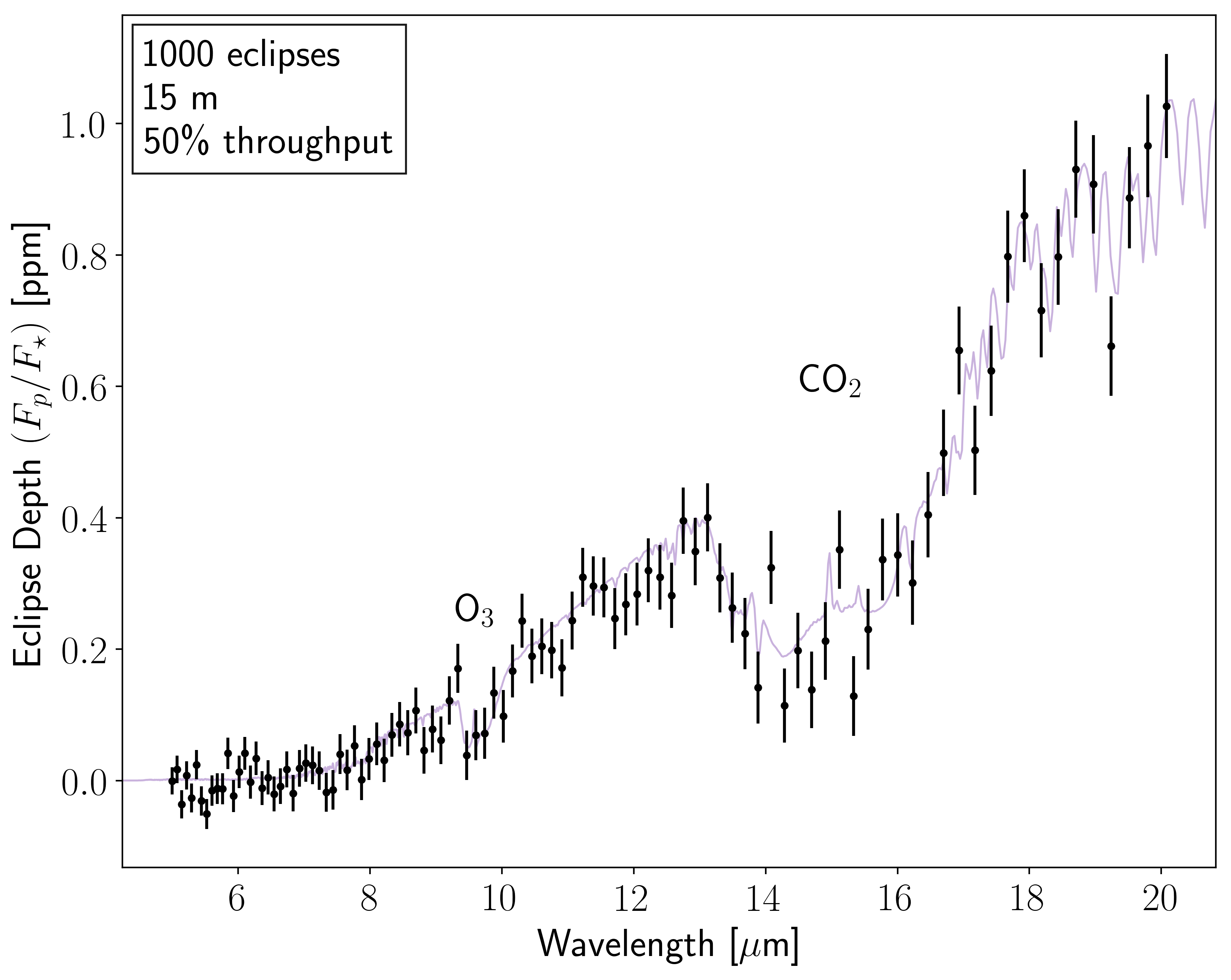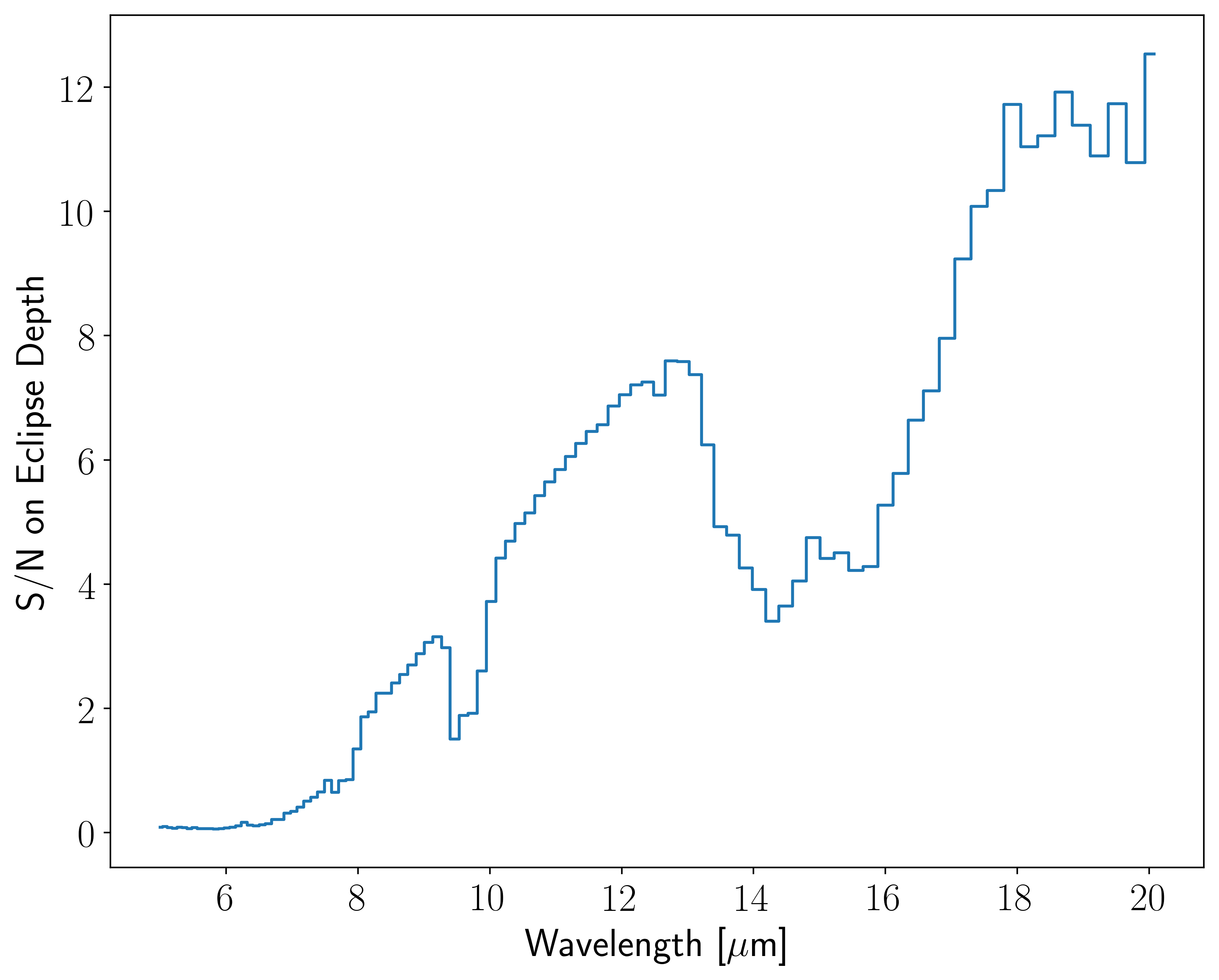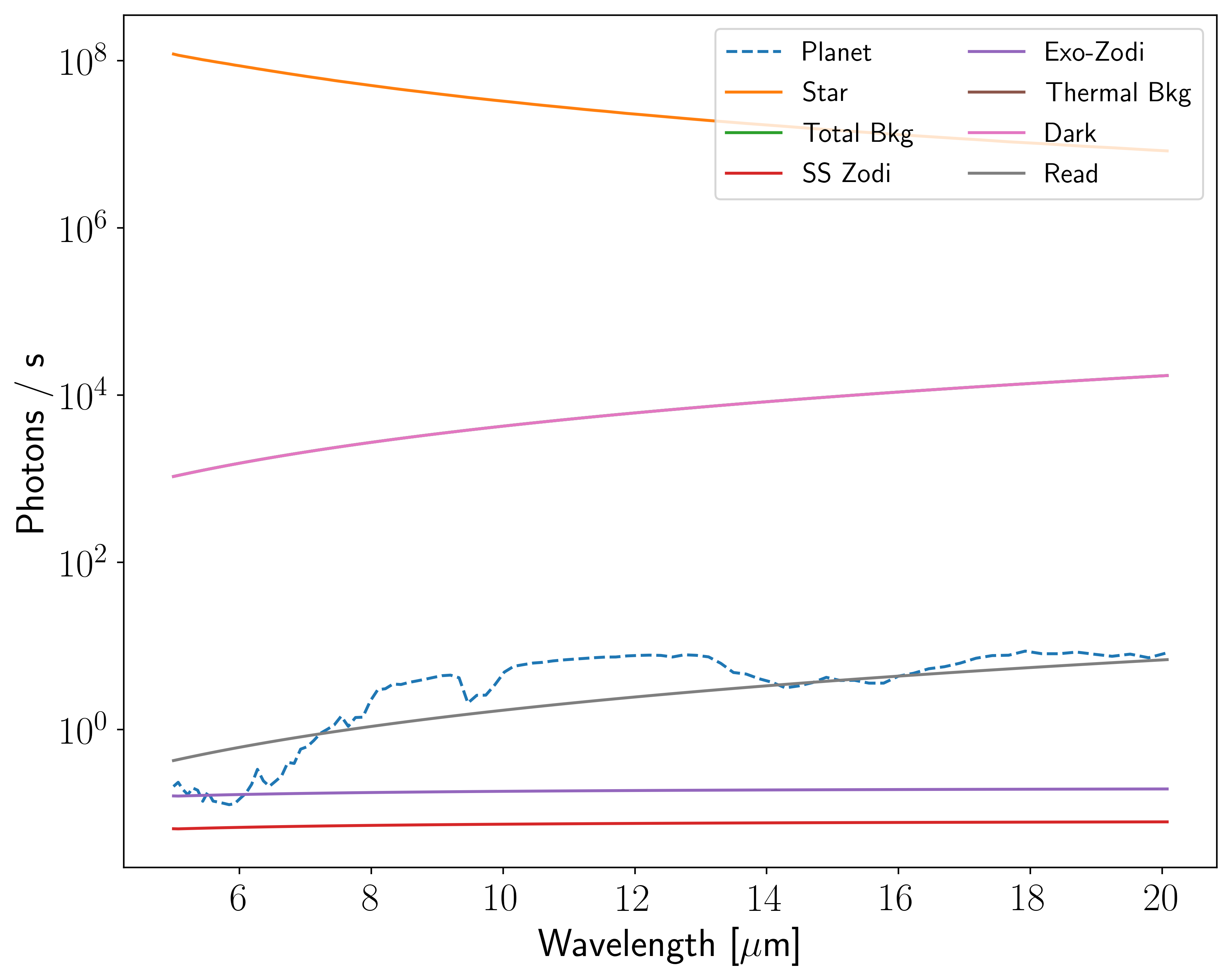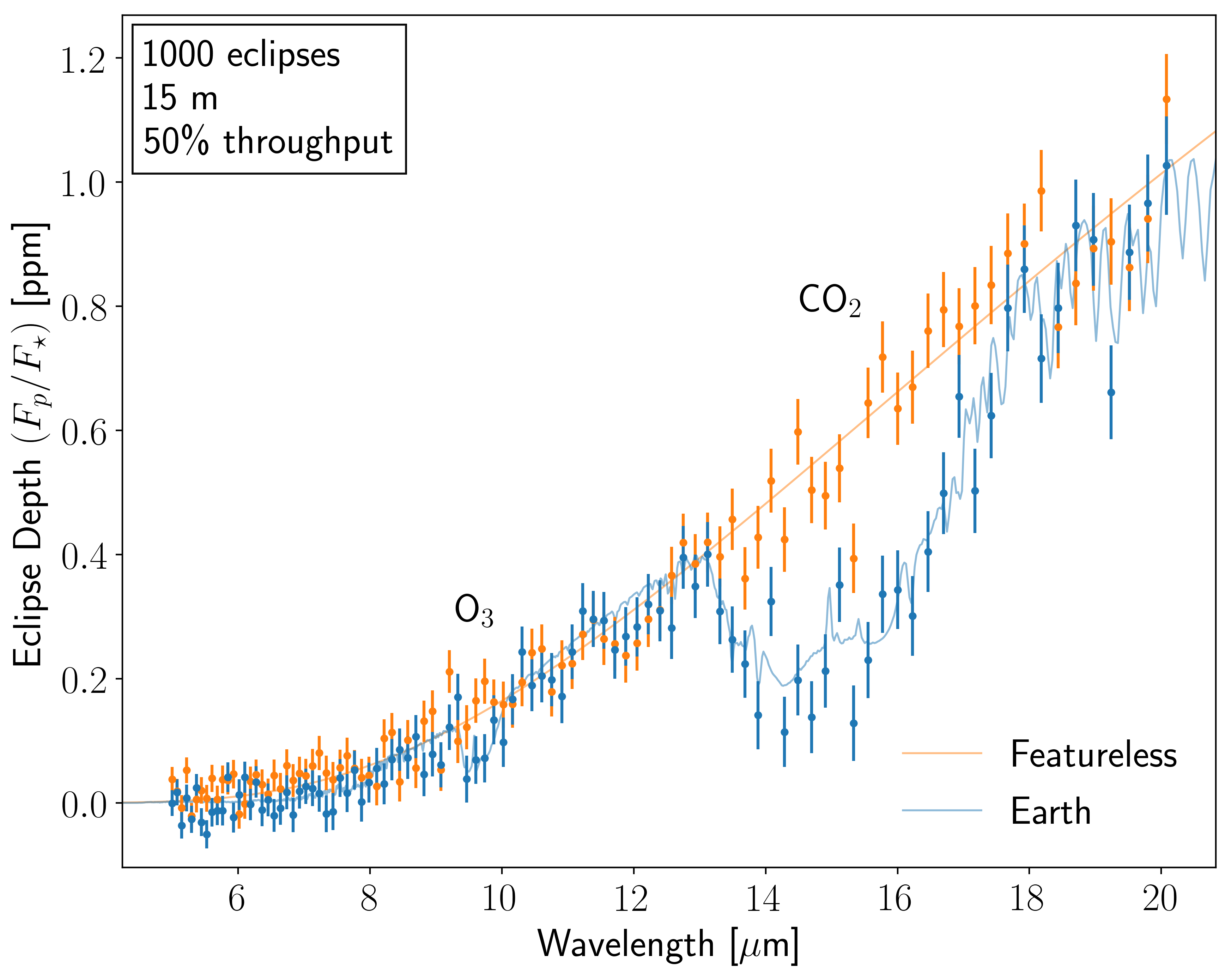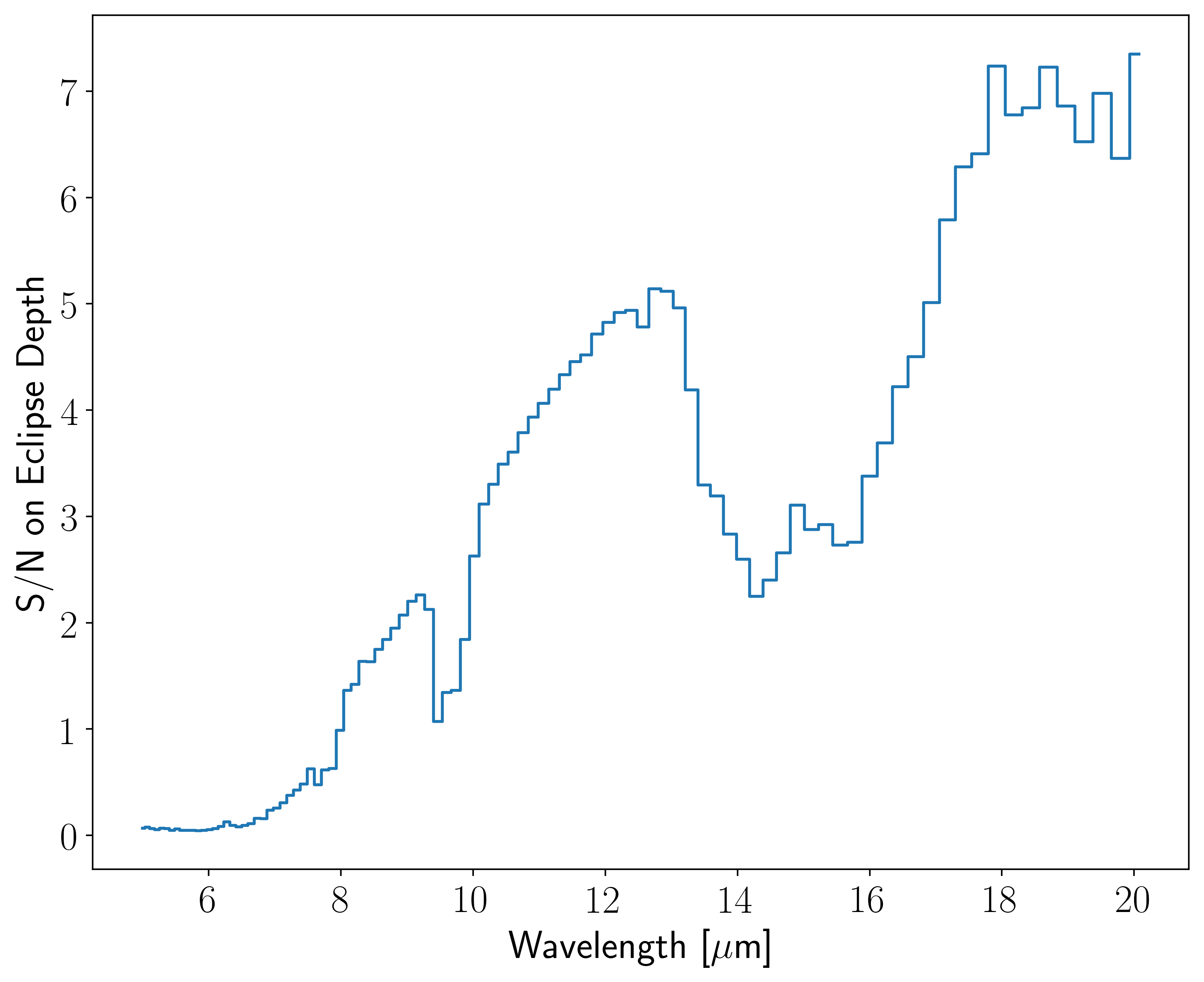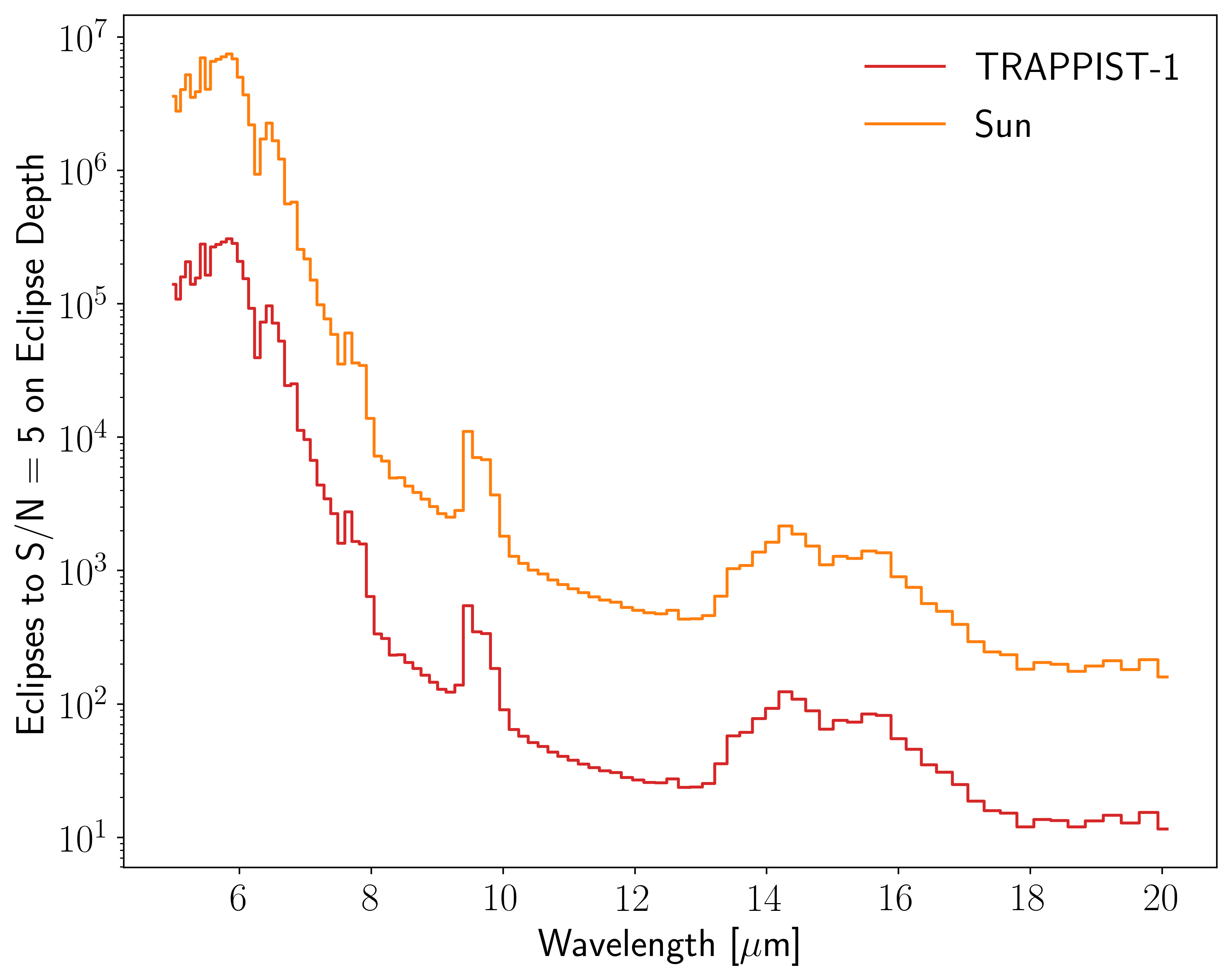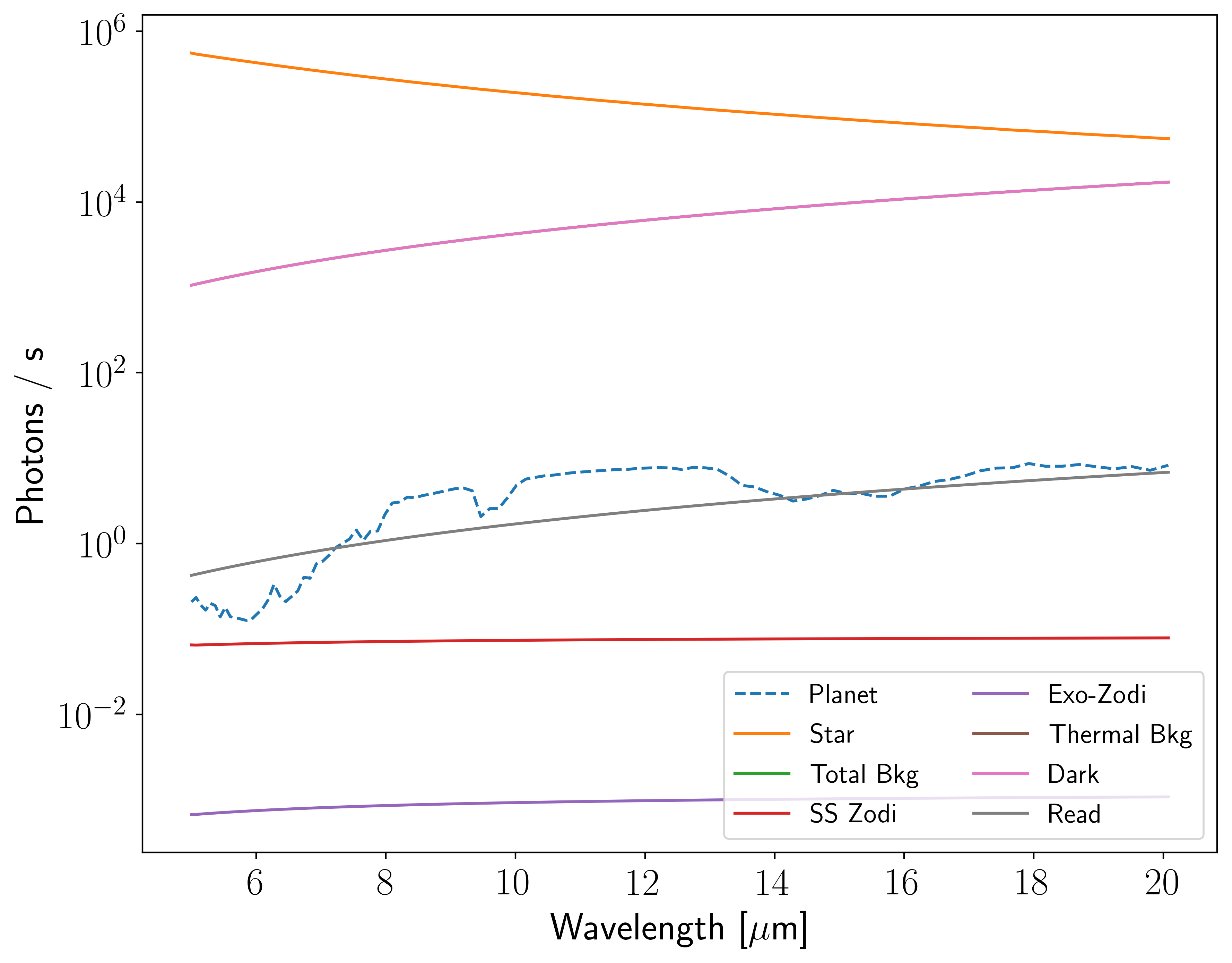Note
This tutorial was generated from a Jupyter notebook that can be downloaded here.
Secondary Eclipse Spectroscopy¶
The coronagraph model can be used to model exoplanet observations using telescopes that don’t even have a coronagraph. Here we will walk through a few examples of how to simulate secondary eclipse spectroscopy using the generic telescope noise modeling tools available with the coronagraph package.
[3]:
import coronagraph as cg
print(cg.__version__)
1.0
Earth in Emission¶
Let’s start out by loading a model spectrum of the Earth:
[4]:
lam, tdepth, fplan, fstar = cg.get_earth_trans_spectrum()
Now we’ll define the telescope/instrument parameters for our simulation. Let’s go big for this demo and use a 15 meter space telescope, with 50% throughput, and a mirror temperature at absolute zero so there is no thermal noise.
[5]:
telescope = cg.Telescope(Tput = 0.5, # Throughput
D = 15., # Diameter [m]
R = 70, # Resolving power (lam / dlam)
lammin = 5.0, # Minimum Wavelength [um]
lammax = 20.0, # Maximum Wavelength [um]
Tsys = 0.0, # Telescope mirror temperature [K]
)
We’ll define the observed system as an Earth-Sun analog at 10 pc.
[6]:
planet = cg.Planet(a = 1.0, # Semi-major axis [AU]
d = 10.0, # Distance [pc]
Rp = 1.0 # Planet Radius [Earth Radii]
)
star = cg.Star(Rs = 1.0, # Stellar Radius [Solar Radii]
Teff = 5700. # Stellar Effective Temperature [K]
)
Now let’s specify the transit/eclipse duration tdur for the planet (Earth is this case), the number of eclipses to observe ntran, and the amount of observing out-of-eclipse (in units of eclipse durations) for each secondary eclipse observation nout. We’re going to simulate the spectrum we would get after observing 1000 secondary eclipses of the Earth passing behind the Sun. Obviously this is ridiculous. One thousand secondary eclipses is not only a minimum of 8000 hours of
observational time, but it would take 1000 years to aquire such a dataset! I promise that there is a lesson to be leared here, so let’s push forward into infeasibility.
[17]:
tdur = 8.0 * 60 * 60 # Transit/Eclipse duration [seconds]
ntran = 1e3 # Number of eclipses
nout = 2.0 # Number of out-of-eclipse durations [transit durations]
wantsnr = 10.0 # Desired S/N per resolution element (when applicable)
Now, we’re ready to instantiate an EclipseNoise object for our simulation, which contains all of the information needed to perform the noise calculation.
[18]:
en = cg.EclipseNoise(tdur = tdur, # Transit Duration
telescope = telescope, # Telescope object
planet = planet, # Planet object
star = star, # Star object
ntran = ntran, # Number of eclipses to observe
nout = nout, # Number of out-of-eclipse observing
wantsnr = wantsnr) # Desired S/N per resolution element (when applicable)
At this point we are ready to run the simulation, so we simply call the run_count_rates method:
[19]:
en.run_count_rates(lam, fplan, fstar)
Let’s now plot our fiducial secondary eclipse spectrum.
[20]:
fig, ax = en.plot_spectrum(SNR_threshold=0.0, Nsig=None)
ax.text(15.0, 0.6, r"CO$_2$", va = "center", ha = "center");
ax.text(9.6, 0.25, r"O$_3$", va = "center", ha = "center");
We can three key features. First, we note the general rising trend in the planet-to-star flux contrast with increasing wavelength. This occurs because, even though the Earth is much much more faint than the Sun at visible wavelengths, the blackbody intensity is weakly dependent on temperature in the Rayleigh-Jeans limit, so at these longer wavelengths the 288 K Earth and 5700 K Sun have more similar intensities. Second, we see absorption due to CO\(_2\) at 15 µm. Finally, we see absorption due to O\(_3\) at 9.6 µm. The rise in planet-to-star flux contrast with wavelength increases the relative size of absorption features in the emission spectrum. At first blush this would appear to make detecting molecules easier at longer wavelengths, however, photons are few and far between at these wavelengths and thermal noise tends to increase with wavelength, making the optimal wavelengths for molecular detection more complicated and telescope-dependent.
Let’s take a look that the signal-to-noise as a function of wavelength.
[21]:
fig, ax = en.plot_SNRn()
Sometimes it’s nice to see the number of eclipses that must be observed to get a given S/N in each spectral element. Let’s take a look at these devastating numbers for the Earth around the Sun.
[22]:
fig, ax = en.plot_ntran_to_wantsnr()
So this is really just too ridiculous. The ultimate reason for that can be gleaned from the last plot in this series, where we take a look at the photon count rates incident upon the detector from various noise sources compared to our signal.
[23]:
fig, ax = en.plot_count_rates()
We see that it’s all about the star. The themral emission from the Sun outshines the thermal emission from the Earth by ~6 orders of magnitude at 20 µm, and there aren’t enough photons to overcome this contrast in any reasonable amount of time.
Simulating a featureless spectrum¶
We’ve heard a lot about featureless transmission spectra. This can occur due to high altitude aerosols or heavy and/or cool atmospheres. But what does a featureless emission spectrum look like?
In short, it looks like a ratio of blackbody fluxes:
But let’s see how we can investigate this with the coronagraph model.
We’re going to use the same planet and star as above, but now let’s set a temperature for the planet:
[24]:
planet.Tplan = 288
Now we can create a new EclipseNoise object for our featureless spectrum and calculate the photon count rates.
[25]:
enf = cg.EclipseNoise(tdur = tdur,
telescope = telescope,
planet = planet,
star = star,
ntran = ntran,
nout = nout,
wantsnr = wantsnr)
enf.run_count_rates(lam)
Let’s plot our new featureless spectrum and compare it with Earth’s emission spectrum.
[26]:
# Plot Spectrum
fig, ax = enf.plot_spectrum(SNR_threshold=0.0, Nsig=None,
err_kws={'fmt': '.', 'c': 'C1', 'alpha': 1},
plot_kws={'lw': 1.0, 'c': 'C1', 'alpha': 0.5, 'label' : 'Featureless'})
# Add Earth's emission spectrum to the axis
en.plot_spectrum(SNR_threshold=0.0, Nsig=None, ax0=ax,
err_kws={'fmt': '.', 'c': 'C0', 'alpha': 1},
plot_kws={'lw': 1.0, 'c': 'C0', 'alpha': 0.5, 'label' : 'Earth'})
# Add legend
leg = ax.legend(loc = 4)
leg.get_frame().set_alpha(0.0)
# Annotate molecules
ax.text(15.0, 0.8, r"CO$_2$", va = "center", ha = "center");
ax.text(9.6, 0.3, r"O$_3$", va = "center", ha = "center");
What about M-dwarfs?¶
So far we have looked at the extremely unrealistic scenario of observing Earth in secondary eclipse around the Sun. Now let’s shift our focus to the late M-dwarf TRAPPIST-1 to see what the Earth would look like in secondary eclipse around this small, cool, dim star.
We’ll start by modifying the effective temperature Teff and the radius Rs of the star:
[27]:
star.Teff = 2510
star.Rs = 0.117
Let’s instantiate an EclipseNoise object but now we’ll use the transit duration of TRAPPIST-1e and only observe 25 secondary eclipses.
[28]:
enm = cg.EclipseNoise(tdur = 3432.0,
telescope = telescope,
planet = planet,
star = star,
ntran = 25.0,
nout = nout,
wantsnr = wantsnr)
enm.run_count_rates(lam, fplan)
Here’s the emission spectrum:
[29]:
fig, ax = enm.plot_spectrum(SNR_threshold=0.0, Nsig=None)
Now we’re in business!
[30]:
fig, ax = enm.plot_SNRn()
[37]:
enm.recalc_wantsnr(wantsnr = 5.0)
en.recalc_wantsnr(wantsnr = 5.0)
fig, ax = enm.plot_ntran_to_wantsnr(plot_kws={'ls': 'steps-mid', 'alpha': 1.0, 'label' : "TRAPPIST-1", 'c' : 'C3'})
en.plot_ntran_to_wantsnr(ax0 = ax, plot_kws={'ls': 'steps-mid', 'alpha': 1.0, 'label' : "Sun", 'c' : 'C1'})
ax.legend(framealpha = 0.0);
Compared to the Sun, studying Earth temperature planets in secondary eclipse around TRAPPIST-1 would require better than \(10\times\) fewer transits to reach the same S/N on the spectrum.
Note that a S/N of 5 on each spectral element says nothing of the ability to detect molecules. The 15 µm CO\(_2\) band as seen in the spectrum above is detected at greater than S/N=5 even though the S/N<5 in each element within the absorption band.
Finally, let’s look at the photon count rates.
[38]:
fig, ax = enm.plot_count_rates()
Now the contrast is \({\sim} 100 \times\) more favorable than the Earth-Sun system. These systems are by no means easy to study, but they are something that we can work with!
